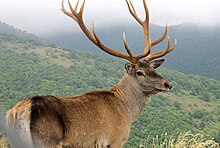| Caspian red deer | |
|---|---|

| |
| Conservation status | |
 Endangered (IUCN 3.1) | |
| Scientific classification | |
| Domain: | Eukaryota |
| Kingdom: | Animalia |
| Phylum: | Chordata |
| Class: | Mammalia |
| Order: | Artiodactyla |
| Family: | Cervidae |
| Genus: | Cervus |
| Species: | C. elaphus |
| Subspecies: | C. e. maral |
| Trinomial name | |
| Cervus elaphus maral (Gray, 1850) | |
The Caspian red deer (Cervus elaphus maral), is one of the easternmost subspecies of red deer that is native to areas between the Black Sea and Caspian Sea such as Crimea, Asia Minor, the Caucasus Mountains region bordering Europe and Asia, and along the Caspian Sea region in Iran. The Caspian red deer is sometimes referred to as maral, noble deer, or eastern red deer.
Classification
The Caspian red deer is a subspecies of the red deer.
Description
The Caspian red deer is around 4 feet 6 inches (1.37 m) tall, and can weigh 500 to 700 pounds (230 to 320 kg). Their antlers are around 4 feet (1.2 m) in length, and 6 inches (150 mm) in girth. Its coat is dark gray, except in the summer, when it is a dark brown. They shed their antlers in late winter and their new antlers reach full growth in late summer. One, occasionally two, fawns are born in mid-spring. The fawns are reddish brown with white spots.
Ecology and behaviour
The Caspian red deer is a social and primarily nocturnal animal. It eats a variety of grasses and leaves and occasionally berries and mushrooms.
Domestication
The Caspian red deer has been domesticated in the 2nd century.
Threats
Within Russia, the Caspian red deer has been hunted for velvet antlers since the 1930s. Historically, demand for velvet antlers from Asia was met by organized deer farms in the Soviet Union. Hunting by humans have been noted as the cause for decreases in population. The approximate number of Caspian red deer in eastern Georgia dropped from 2,500 in 1985 to 880 in 1994. Their primary predators include Persian leopards and, to a lesser extent, wolves and brown bears. In the past they were also hunted by the now-extinct Caspian tiger.
References
- Shokri, Shirko; Jafari, Abbas; Rabei, Korous; Hadipour, Ehsan; Alinejad, Hossein; Zeppenfeld, Thorsten; Soufi, Mobin; Qashqaei, Ali; Ahmadpour, Mohsen; Zehzad, Bahram; Kiabi, Bahram H.; Pavey, Chris R.; Balkenhol, Niko; Waltert, Matthias; Soofi, Mahmood (2021). "Conserving populations at the edge of their geographic range: the endangered Caspian red deer (Cervus elaphus maral) across protected areas of Iran". Biodiversity and Conservation. 30 (1). Springer Link: 85–105. Bibcode:2021BiCon..30...85S. doi:10.1007/s10531-020-02077-4. S2CID 254283122. Retrieved 2 October 2022.
- Henry Charles Howard Suffolk and Berkshire (Earl of); Hedley Peek; Frederick George Aflalo (1911). The Encyclopaedia of sport & games. J.B. Lippincott company. p. 76.
- ^ Encyclopedia of Meat Sciences: 3-volume set. Elsevier Science. 22 July 2014. p. 194. ISBN 978-0-12-384734-8.
- ^ Henry Charles Howard Suffolk and Berkshire (Earl of); Hedley Peek; Frederick George Aflalo (1911). The Encyclopaedia of sport & games. W. Heinemann. p. 262.
- ^ Eskandar Firouz (14 October 2005). The Complete Fauna of Iran. I.B.Tauris. p. 83. ISBN 978-1-85043-946-2.
- Jörg Gertel; Richard B. Le Heron (2011). Economic Spaces of Pastoral Production and Commodity Systems: Markets and Livelihoods. Ashgate Publishing, Ltd. p. 232. ISBN 978-1-4094-2531-1.
- Alison Davidson (1 August 2000). Velvet Antler: Nature's Superior Tonic. SAFE GOODS/New Century Publishing 2000. p. 13. ISBN 978-0-9701110-0-5.
- Tim Burford (2011). Georgia. Bradt Travel Guides. p. 10. ISBN 978-1-84162-357-3.
External links
| Taxon identifiers | |
|---|---|
| Cervus elaphus maral | |
This article about an even-toed ungulate is a stub. You can help Misplaced Pages by expanding it. |